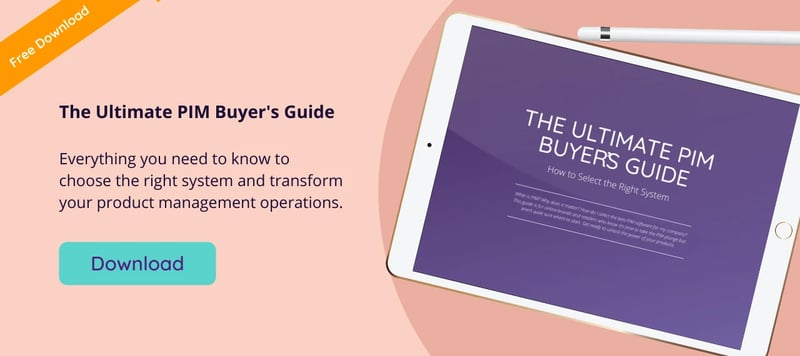Q&A with CS: Headless Commerce and Shopify

Keep the good stuff coming
Subscribe to our blog newsletter and get monthly content that helps you manage product data smarter.
No spam. Just real value.
Today, customers demand full control of their shopping journeys—from start to finish.
They get to decide if they’re going to visit a physical store or shop directly from your web store. Whether it’s day or night, they’re in control, and most importantly, they have expectations that need to be fulfilled. One such expectation is a seamless, non-disruptive experience.
This means that they want to have the same shopping experience across every channel. After all, they don’t know what’s happening in the background. They expect instant changes and want to see them on your storefront. So, that’s where headless commerce comes in.
Now, you might be asking yourself so many questions: what is headless commerce? How does this work? Is it really worth your time as a small business owner? Can you do it for your Shopify store? So, we’ve enlisted the help of the Head of Customer Success at Plytix, Jon Gorospe, and our ecommerce specialist, David Alarcón, to answer these questions for you.
1. Can you share a simplified explanation of what headless commerce means?
There’s a big difference between headless and traditional models. The traditional model is more centralized, but it is less agile. That means that you have an online store where you store your products, and you have one storefront attached to it. This creates a limit when it comes to delivering other types of content because your storefront only shows your linked data.
Now, the headless commerce concept offers you limitless possibilities to deliver various types of content to customers because your backend data is not coupled with a storefront. That allows you to adapt all of your content to different devices, platforms, and user interfaces.
“Let’s say that traditional ecommerce would be selling in your web store and in one app (if your system supports it). Then, headless would be selling in your web store, in an app, on any social platform like Facebook, for example, and in a physical PoS or kiosk, or in any smart device. Now, thanks to the application programming interface (API), all of those integrations are connected. Each of these channels represents a different front end,” says David Alarcón.
2. Other than the seamless experience for customers, are there benefits for store owners? What can they get from investing in headless site architecture?
According to Jon: “Absolutely! Headless commerce doesn’t only improve the buyer’s experience, but it also helps the organizations in many different ways. It opens up a world of possibilities. It can allow businesses to be available in many different sales channels and enter other markets that they may not have been able to tap into before.” Unlike traditional commerce, where there’s a disconnect between operating systems and commercial silos, a headless strategy helps retailers sell anywhere they choose. Why? Because there’s a central source that connects all of the data they need to sell and deliver products to customers. That can be PIM for you.
But there are more benefits. Flexible frontend development eliminates the need to update backend functions, which allows for easy adaptability to new channels. The testing is also faster, and iterations can be made more quickly. There are increased possibilities of integration with third parties and increased scalability due to the "out of the box" development concept.
3. Does headless commerce work well for multistore and multichannel selling?
“Yes, of course,” says Jon. “Multistore and multichannel basically mean having different sales channels to sell from, and to different markets, with different languages and currencies."
"What makes headless commerce architecture work in this instance is when you have five different channels for five different markets. It streamlines what you do for these five and enables you to do everything in a single source of truth instead of five different siloed sources.”
4. Would you say there are cons to headless commerce? Particularly for SMBs?
Yes, there are cons.
Jon says, “you need a very solid infrastructure and engineering team. Not to mention, it can come with a hefty price. The engineering of it is not something that you can simply plug and play or just do with a few plugins here and there. But I will say that the most important thing is its scale. However, an SMB can still use the headless approach and do it on a smaller scale."
"But what would that look like? Well, say, for example, you have a small physical shop or an online shop, and you decide to sell through Amazon, Walmart, or eBay. A headless commerce approach would require that you sync all of your orders to go through the same warehouse and manage all orders through the same system. That means you don’t take orders from five different places through five different systems and then have five different order codes.”
He continues …
“You do it through one source. So, no matter where the order comes from, it can be sorted through the main source, and the fulfillment process can take place without any issues.”
5. Would you say that headless commerce is the future?
Jon shares ...
“Well, it’s the present for the buyers and should be the future for the sellers that want to adapt and deliver a seamless experience to customers. I mean, you're going to be making way more money on your own website than on Amazon, right? So it makes sense to go headless.”
“Let me put it this way: Amazon is a place where you can be found; it's a huge marketplace. So, you need to have a strategy in place that allows you to sell for the first time to a new customer on Amazon, and then when you deliver the product, you take over with strong branding and personalization that will intrigue the customer to look more into you. Maybe they will visit your Instagram account and follow you. Then, all of a sudden, they like your products, and they eventually end up on your website. Now that they know about your brand, they have the option to buy from your website or Amazon, or both.” He continues, “but what’s important is that wherever they end up shopping from, they get the same experience throughout."
That's what headless commerce can offer: seamless customer experiences.
6. Can you go headless on Shopify, and is it easy to do so?
Yes, you can go headless on Shopify, but it doesn’t mean it’s easy.
Jon says, "when organizations decide to go headless, they have to carry that task independently. “What I see a lot of is that people create their own applications and use their coding resources to bring headless commerce to life.” As you can imagine, this takes time.
7. What Shopify apps and third-party integrations can facilitate going headless?
Shopify has many plugins and APIs that you can use to connect things. But it’s all up to your developers and how they want to set up your site architecture when they decouple the frontend from the backend. A PIM tool can be used to make processes easier. For example, you can have your rich product information in the tool, and your frontend can be your channel.
8. Does headless commerce make product information management easier?
“In a sense, it's quite the opposite, which is why we suggest PIM,” says Jon. “When you go headless, managing your product data becomes even more of a challenge because you have to make changes to the content and improve it by optimizing it to make sure it meets channel expectations. If you add a new market(s) or channels, that’s even more data to manage. Depending on the number of markets and channels you've added, the product titles, descriptions, images, and other digital assets would double or triple. It just multiplies, right?”
9. Would you recommend using a PIM in this process?
Yes, absolutely!
Any company that wants to build a structure in their backbone (product content) needs to consider PIM. Managing all of that content will be humanly impossible without a product information management system. A PIM organizes and stores all content in a single location.
Jon says, “that way, when you’re done with decoupling your frontend and backend, you simply pull all necessary data from one place and distribute it where it needs to go. You can develop a headless commerce set up, but customers will not be happy if you have a sales channel missing product information. So, in short, PIM is a perfect bridge between content people and IT people. It helps them work together to prepare headless commerce for a retail organization.”
10. How does Plytix PIM help in this aspect?
Plytix has a very easy-to-use interface with features that anyone can use. You don’t need to have any qualifications in coding or software engineering to use Plytix PIM. All you need to do is store and enrich the quality of your data. Manage that overtime, and you’ll be fine.
According to Jon, “Plytix product information management has feed builder capabilities that IT people can use, and we have well-created API documentation. It's a dream for any developer to have access to an API like ours. It makes integrations to different multiple systems easy.”
Final say
Plytix simplifies product content management and can play a huge role in your journey to headless commerce. Whether you decide to go headless now or in the future, save yourself the headache and add Plytix to your ecommerce starter tech stack today. To chat about your data management needs, simply book a demo, and Jon will happily get you started in PIM.

What if your product data actually worked for you?
We’ll show you how Plytix helps you stop fixing data—and start using it.
Related posts
Keep the good stuff coming
Subscribe to our blog newsletter and get monthly content that helps you manage product data smarter.
No spam. Just real value.






Think others should see this?
Go ahead and share it.